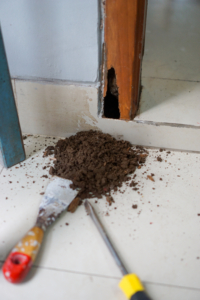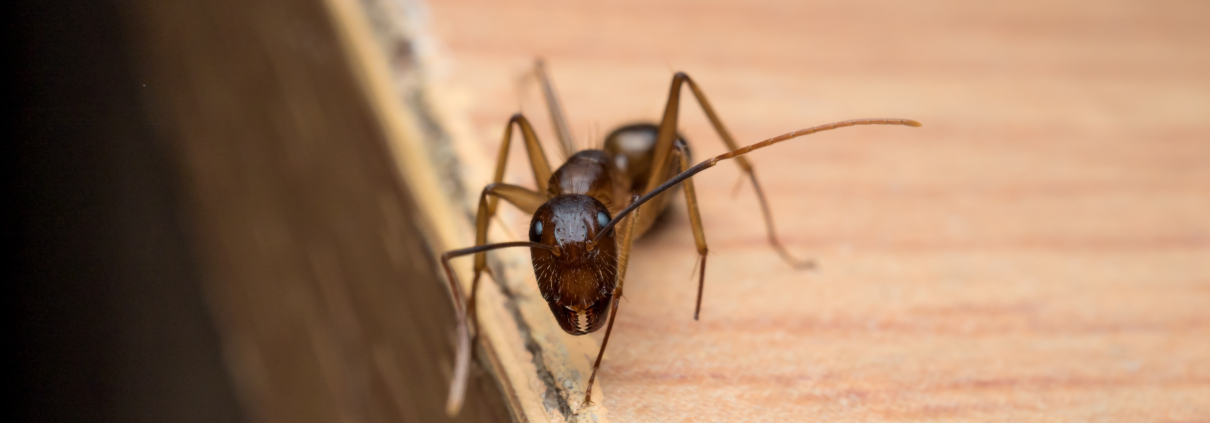Carpenter Ants
As a homeowner, it’s crucial to be aware of potential threats to your property, and one such threat comes in the form of carpenter ants. These insects possess impressive carpentry skills, but they can also cause significant damage to homes if left unchecked. In this article, we’ll take a closer look at carpenter ants, their habits, and the steps you can take to protect your home from these unwanted guests.
Understanding Carpenter Ant Behavior:
Carpenter ants, scientifically known as Camponotus spp., are a common nuisance for homeowners. Unlike termites, they do not consume wood but excavate tunnels and galleries within wooden structures. These nests serve as their homes, where they create intricate passageways and establish colonies that can number in the thousands. Unfortunately, their nesting behavior can lead to severe structural damage over time.
Carpenter ants are primarily active during the night and prefer moist or decaying wood for nesting. The presence of moisture in the woods aids in the growth of eggs and larvae of carpenter ants. They can be found in various areas of your home, such as attics, crawlspaces, decks, or porches. Understanding their behavior and nesting preferences can help you target your efforts to eliminate them effectively. By identifying their preferred habitats, you can implement preventive measures specific to those areas and reduce the risk of infestation.
Identifying Carpenter Ant Infestations:
To protect your home, it’s crucial to identify carpenter ant infestations early on. Look out for winged ants indoors, particularly during spring when they swarm to establish new colonies. Additionally, keep an eye out for sawdust-like frass, which they discard near their nesting sites. Piles of wood shavings or tiny holes in wooden structures are also telltale signs of their presence. By recognizing these signs, you can take prompt action to address the issue before it escalates.
RELATED ARTICLE:Termite & WDO Inspections
Taking Preventive Measures:
Prevention is key when it comes to carpenter ants. Start by eliminating any sources of moisture, as these pests are attracted to damp environments. Repair leaks promptly and ensure proper ventilation in areas prone to excess moisture. Trim tree branches and vegetation that may provide bridges for ants to access your home. Additionally, seal any cracks or gaps in the foundation, walls, or windows to deny them entry. By proactively addressing these vulnerabilities, you can create an inhospitable environment for carpenter ants.
Regular Inspections and Maintenance:
To prevent carpenter ant infestations, regular inspections and maintenance are essential. Routinely check for signs of damage, such as weakened wood or hollow sounds when tapping on wooden surfaces. Keep firewood away from your home’s exterior and trim vegetation regularly. By maintaining a vigilant approach, you can stay one step ahead of these destructive pests. Consistency in inspections and maintenance can help you detect and address any vulnerabilities promptly.
Natural Remedies and Chemical Treatments:
Various natural remedies and chemical treatments are available for controlling carpenter ants. Natural remedies include diatomaceous earth, boric acid, or essential oils like tea tree or peppermint oil. These substances can be applied strategically to deter ants or disrupt their colonies. Chemical treatments, on the other hand, should be handled by professionals to ensure safety and efficacy. It’s essential to weigh the pros and cons of each approach and choose the one that aligns with your preferences and circumstances.
Professional Assistance:
If you suspect a carpenter ant infestation or notice significant damage to your property, it’s advisable to seek professional assistance. Pest control experts can accurately identify the extent of the infestation, locate nests, and employ effective eradication methods. They can also provide guidance on long-term prevention strategies to safeguard your home. Trusting the expertise of professionals can give you peace of mind and ensure the most efficient resolution of the issue.

Protecting Your Home, Preserving Your Peace of Mind:
Understanding the threat posed by carpenter ants and implementing preventive measures can go a long way in protecting your home. By taking proactive steps, seeking professional assistance when needed, and maintaining regular inspections, you can keep these unwanted guests at bay and enjoy a pest-free living environment for years to come. Safeguarding your home not only preserves its structural integrity but also provides you with the peace of mind and comfort you deserve as a homeowner.




